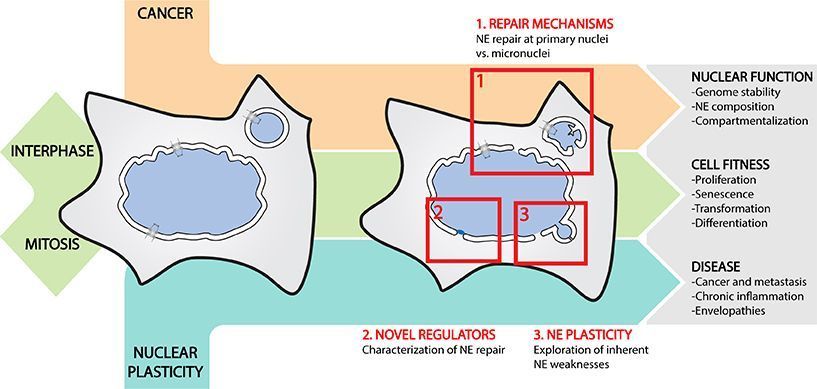Main research question
The Nuclear envelope dynamics project aims to characterize the pathways triggered by changes in NE topology, and to understand how these pathways affect cell fitness and fate. To address this, we focus on
- The mechanistic regulation of NE integrity during cell division, interphase, and in micronuclei.
- The effects of compromised of NE integrity on genome integrity, cell fitness and fate.
- The consequences of nuclear lamina defects for NE functionalization and nuclear integrity during adipocyte differentiation.
- The response of the NE to mechanical strain.
To address these questions, we use mechanistic cell biological studies that revolve around live-cell microscopy, proteomics, and genetics approaches in non-transformed cell lines, cancer cell lines, as well as primary cell models.
Movie: Cells undergo transient loss of nuclear integrity, as monitored by leakage of a nuclear fluorescent marker into the cytosol (in red, mCherry-NLS). These ruptures are accompanied by transient recruitment of the membrane repair machinery to the sites of rupture (in green, CHMP4B-mNG) resulting in restoration of nuclear integrity as evidenced by nuclear re-accumulation of mCherry-NLS.
Recent findings
- Unrestrained ESCRT-III drives micronuclear catastrophe and chromosome fragmentation
- The ESCRT-III machinery regulates nuclear envelope reformation during mitotic exit
Funding
- The Research Council of Norway
- South-East Norway Regional Health Authorities
- The University of Oslo
Collaborations
- Nolwenn Briand and Philippe Collas, Department of Molecular Medicine, Institute of Basic Medicine, University of Oslo, Oslo, Norway
- Marina Vietri and Harald Stenmark, Institute for Cancer Research, The Norwegian Radium Hospital, Norway
- Sebastian Schultz and Andreas Brech, Institute for Cancer Research, The Norwegian Radium Hospital, Norway
- Roland Knorr, Max Plank Institute of Colloids and Interfaces, Department of Theory & Bio-Systems, Potsdam, Germany
- Francesca Micci, Section for Cancer Cytogenetics, Institute for Cancer Genetics and Informatics, Oslo University Hospital, Oslo, Norway
- Halim Kusumaatmaja, Department of Physics, Durham University, Durham, UK
- Sushma Grellscheid, Computational Biology Unit, Department of Biological Sciences, University of Bergen, Bergen, Norway
